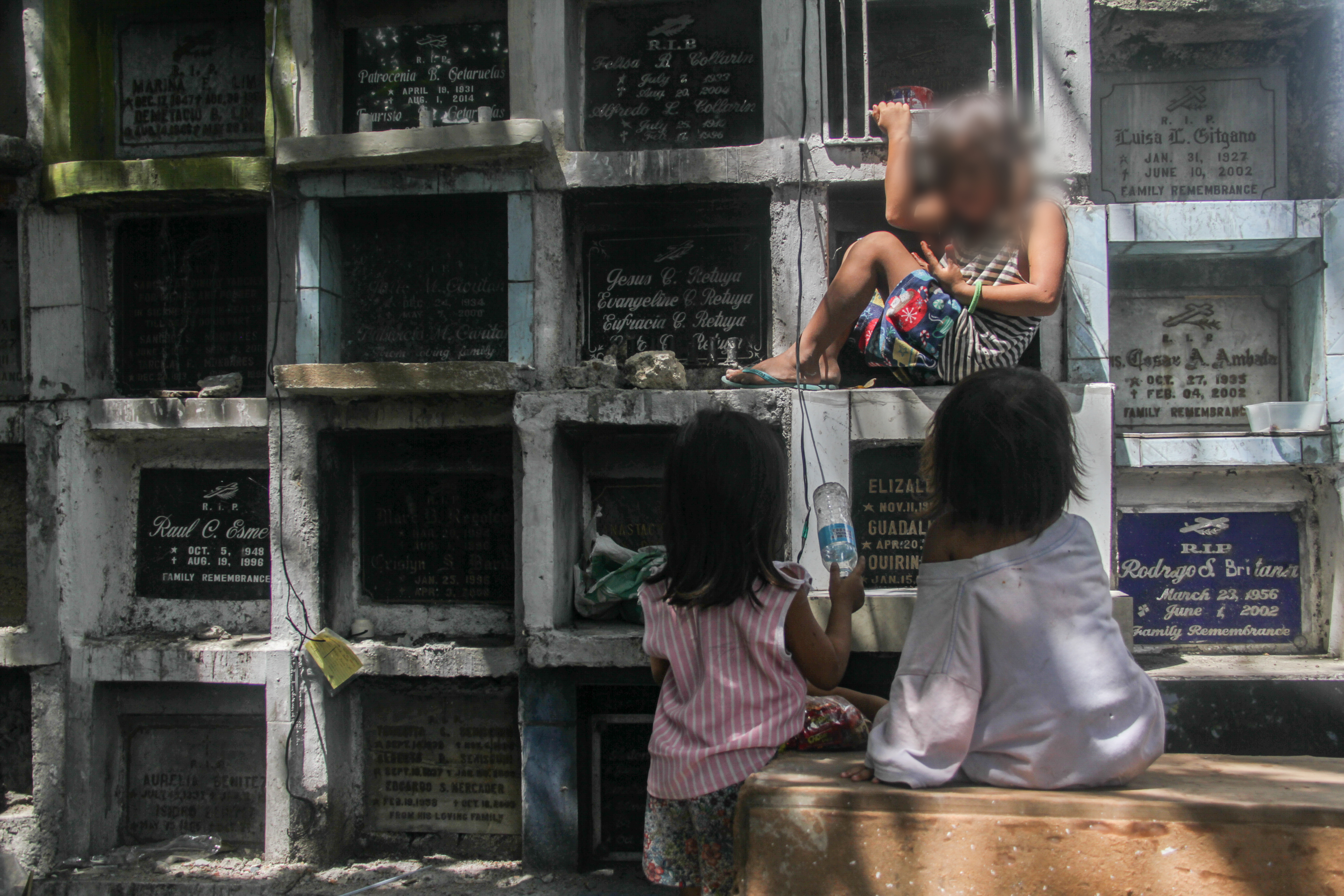
The grandchildren of Ereberto and Celia Ramirez play among the tombs at the Carreta Cemetery. It has been 30 years since the Ramirez lived inside the cemetery. |CDND PHOTO / Gerard Vincent Francisco
CEBU CITY, Philippines — Surrounded by tombs and crosses, Celia and Ereberto Ramirez raised a family of six children inside the Carreta Cemetery.
It was not the ideal home to nurture infants or raise toddlers.
But somehow, the niches became the unlikely playground for Arlene and her five siblings.
Growing up, the Ramirez brood lived in an abandoned mausoleum that was reportedly owned by a prominent Cebuano family with the same last name as Celia and Ereberto.
The couple found the Carreta Cemetery after walking from the Cebu City’s pier to M. J. Cuenco Street in search for a place to live.
There were other families living in the neighboring mausoleums too, says Celia.
The people there worked as caretakers and tombstone makers. Others are scavengers.
They learned the tricks of the trade by observing their “neighbors.”
Perhaps it was the fact that the mausoleum also carried their last name that Celia and Ereberto felt truly at home in the cemetery.
Settled in the mausoleum, Celia says they met with the then caretaker of the mausoleum, whom she described as the former chief of Barangay Santo Niño.
The creases on Celia’s forehead deepened when she tried to remember the name of the person.
She has forgotten the person’s name but she is sure that the caretaker told them that they could stay because the mausoleum is empty.
Unique history
Cebu City’s Carreta Cemetery has its own unique story to tell.
It is the resting place of family members belonging to Cebu’s well-known clans; the Osmeñas being one of them.
Dr. Jose Eleazar “Jobers” Bersales, archaeologist and curator of the University of San Carlos Museum, wrote in his Cebu Daily News column in 2014 that the Osmeña Mausoleum was originally constructed in 1918 after the sudden demise of
Doña Estefania Veloso, the first wife of Don Sergio Osmeña.
Bersales writes: “Originally constructed akin to a Greek pantheon shortly after the sudden demise in 1918 of Doña Estefania Veloso, the first wife of Don Sergio Osmeña, the building used to lord it over the landscape in the early 1920s.”
Bersales’ column then discussed his side on the plan of then Cebu City mayor Michael” Mike”Rama to transform the Carreta Cemetery into a historic memorial park.
The plan has not materialized up to this day but Bersales wrote that Cebuana architect Soccoro Atega, who was trained at Harvard University, already has a plan for the cemetery back in 2008.
READ: Carreta as a historic memorial park
Residents of Carreta Cemetery were relieved when the planned park did not come to fruition.
Because it will mean being displaced from the very place where they earn money to support their families.
Carving tombstones is one of the main skills of the Ramirez family. | CDND PHOTO / Gerard Vincent Francisco
Legacy
Before he died in 2005, Ereberto was able to pass on his skills in tombstone making to his children.
Jovin, 24, says he learned to carve from other makers too.
This has been his profession for over five years alongside his older brothers, Rodgin and Erwin. Their brothers-in-law are also in the same business.
Jovin says each person can carve four tombstones per day.
Each tombstone is worth P200 to P1,000 depending on the type of stone and the number of words to be carved.
Business is brisk two weeks before All Saints’ Day and All Souls’ Day as each family earns between P20, 000 to P30, 000.
This is a once-a-year spectacle for the Ramirezes as the rest of the year is all about making ends meet or looking for customers to hire them to do the work.
“Mahimo mig one day millionaire. Pait kaayo apan mao man ni ang nakabuhi namo,” says Arlene, 33, the eldest daughter of Celia and Ereberto.
(We become one-day millionaires. It is difficult, but this is our way of life.)
Dream house
Their home at the Carreta Cemetery may be a comfort zone for her children and grandchildren but Celia hopes that they will be able to leave the place.
Celia suffered a devastating stroke in 2018 which make it difficult for her to express her thoughts.
But she was able to share to CDN Digital her 30-year-old wish.
She looked around her before saying: “Gusto kog balay (I want a house). “
These days, Celia is too sick to clean tombs or do any physical work.
She now tends to her sari-sari store and helps in looking after her grandchildren.
Celia says she is grateful for the blessings they received in the last 30 years.
But she admits her regrets in not being able to send her children to college.
Celia herself only finished elementary school.
This is the mausoleum at the Carreta Cemetery that H! served as the home of the Ramirez family for 30 years. To the left is the sari-sari store that Celia Ramirez tends to augment the family’s income.| CDND PHOTO / Gerard Vincent Francisco
“Para sa akong mga apo, maayo unta mausab among kapalaran. Unta sila maka makahuwam og eskwela ug makakita og nindot nga trabaho,” she says.
(For the sake of my grandchildren, I hope our fate would change. I hope they will be able to finish school and find good jobs.)
The Ramirez matriarch says she no longer wants any of her descendants to live among the dead, trying to make do with whatever they will find in the cemetery to feed themselves.
But this does not mean that she loves the Carreta Cemetery any less.
When death comes knocking on her door, Celia says she would want to be buried in the same cemetery where her husband lies.
It was at the Carreta Cemetery that Celia built a family with Ereberto, where they lived a life full of love despite the hardships. / celr